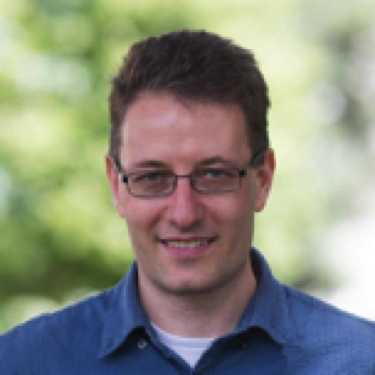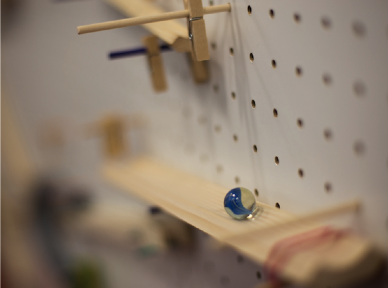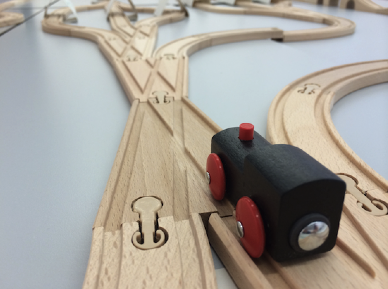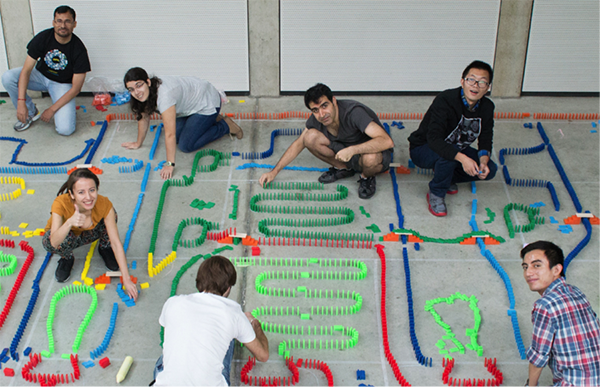CIRCL perspectives offer a window into the different worlds of various stakeholders in the cyberlearning community — what drives their work, what they need to be successful, and what they think the community should be doing. Share your perspective.
Matthias Hauswirth is an Associate Professor at the Faculty of Informatics of the Università della Svizzera italiana (USI) in Lugano, a young research university in the mediterranean, “most beautiful” part of Switzerland. Matthias spent 10 months in 2015-2016 as an International Fellow at the Center for Technology in Learning (CTL) at SRI International working with the CIRCL, PACT, and STEM+C Thinking Outside The Box teams. Matthias is a great example of an expert in a field who cares about learning.
See Matthias’s blog Learning to program? Or programming to learn?
How did you get interested in technology and learning?
I always liked to explain things to people. And I always liked computers. I started by explaining computers and programming to my classmates in middle school. I still remember how I printed a huge banner for the classroom wall and presented on how to program in BASIC. Then, when I was in the army in Switzerland, I had to teach soldiers in my group how to repair communications equipment. That was kind of boring, so I used some of the time to teach them programming. That was much more fun. After that, I taught at the college where I got my bachelor’s degree. Then I went to the U.S. for graduate school to study programming languages. In that research area, I was interested in how developers understand how a program works, and how to debug and tune performance. I stayed in computer science for my dissertation and my academic position. But I’ve always been interested in the human element – the software engineer as learner.
After I got tenure, I decided I wanted to do more work and research on how technology can help educate people. As an assistant professor, I started doing side projects where I developed tools and technologies to support learning and my own teaching, and I started to publish a little about it. One example is the student-built and operated interactive science center that I organized, dubbed a “Pop-up Exploratorium” by a CTL colleague.
Tell us more about the “Pop-up Exploratorium”!
This was a 3-day informal learning event to celebrate the 10 year anniversary of our Faculty of Informatics. Originally, the idea was to do a few public lectures. But, inspired by my visits to places like the Exploratorium, The Tech Museum of Innovation, and the i-factory at the Swiss Museum of Transportation, I pushed my colleagues to do something bigger – something to really encourage the next generation to go into informatics and help adults in the community understand what was going on at our university.

Exhibition Space: Hands-On Activities Grouped into 8 Research Areas
The event offered about 40 hands-on activities straddling the 8 research areas of our faculty – all fully interactive, designed by students and faculty to explain to kids and the public how computer science works – as well as several workshops and seminars. Each activity was led by a faculty member and graduate student, with most of the work done by 2-3 undergraduates. In all, about 200 university students were involved. All classes were canceled for the week. We had about 1000 attendees: 500 high school students, and 500 from the public. The activities illustrated computer science and computational thinking in an accessible way.
One thing that was funny about this informal learning event was that it was fairly low tech. Besides getting inspiration from real-world science centers, we also found many great low tech activity ideas on the Internet. We did it mostly unplugged, using things like wooden train tracks, Lego bricks, paper, and domino pieces.
We even had a seminar on informatics and child development, jointly held by a pediatrician and a faculty member. It was wonderful to see so many strollers in a university classroom! The big finale each day was when students turned on the “domino computer” they built.
Originally, I wanted to include middle school and elementary students, but I didn’t get an okay to invite them. When I asked my fellow faculty members to explain their research to kids, many said “I can’t do that!“ I thought that everything could be explained—and bringing in the graduate and undergraduate students really helped in that. It was an amazing experience. I was very happy with the outcome, and it was a great learning experience for the students who organized it.
Right now I’m co-chairing SPLASH-E, the education strand of the conference on Systems, Programming, Languages and Applications: Software for Humanity. We set up SPLASH-E so that rather than submitting the usual papers, we have a working session where researchers get together and come up with ways to teach the most fundamental concepts in programming languages to school-age kids. What are the foundational concepts that everyone should understand? If we can’t explain them to a kid, they may not be foundational. My aim at the conference is to help people who are currently doing research in programming languages communicate with education researchers about what they think are the key topics to be taught and assessed.
What are some other education projects you have worked on?
I built, used, and published a few papers on Informa, a software-only classroom response system that lets students do things like draw a graph and submit the graph or write a piece of code and submit the code. The uniqueness of the system was that it was not multiple choice, and it had a pedagogical script around it. For example, the instructor poses a question, students solve and submit solutions; after submission, the students view other students’ solutions and grade them. The teacher sees a matrix of everything submitted and graded to help them determine if a concept is clear or not. Crowdsourcing the assessment this way also helps the students see the diversity of possible solutions. That triggers a lot of questions. I used this “solve, evaluate, discuss” activity in my undergraduate Java programming class as the first activity, and then lectured based on the discussion.
A final example was a mastery learning system and approach that I developed. It failed miserably the first time I used it. Since I came here, I understand more about why it failed. My views have changed a lot!
How has your time at CTL had an impact on your thinking?
By spending time at SRI, I was able to connect several loose ends. In some cases, I rediscovered pedagogical approaches that I originally tried in an unprincipled way but wasn’t doing very effectively. I think academics who care about teaching and learning would benefit from working with learning scientists to develop a better understanding of how people learn. Using a sabbatical for that is even better!
The experiences I had here were very diverse. I had many conversations about learning and cognitive science that were incredibly useful for me. I read chapters in the Cambridge Handbook of the Learning Sciences, watched many webinars, and interviewed people for CIRCL perspectives. I also reviewed and documented cyberlearning-related journals, conferences, and efforts outside of the U.S on the CIRCL web site. Helping organize the Cyberlearning 2016 gallery walk and roundtables meant that I learned about every submitted project (about 60 of them), which gave me a large exposure to the kind of work going on in the field. At SRI, I also helped create content for a middle school computer science project that uses dynamic representations, assessments for computational thinking, and analyzed videos of programming.
Before, I was in this narrow world of my students in my course. I was surprised by the complexity of real world learning science research. For example, in the PACT project to assess computational thinking practices, you have to use the curriculum someone else developed. In the future, if I want to do more research on learning, I can’t be the only subject in my study!
Going forward, I’ll be involved in CIRCL’s international workshop at EC-TEL. And I’m looking forward to hosting many new friends who will visit me in beautiful Lugano!






